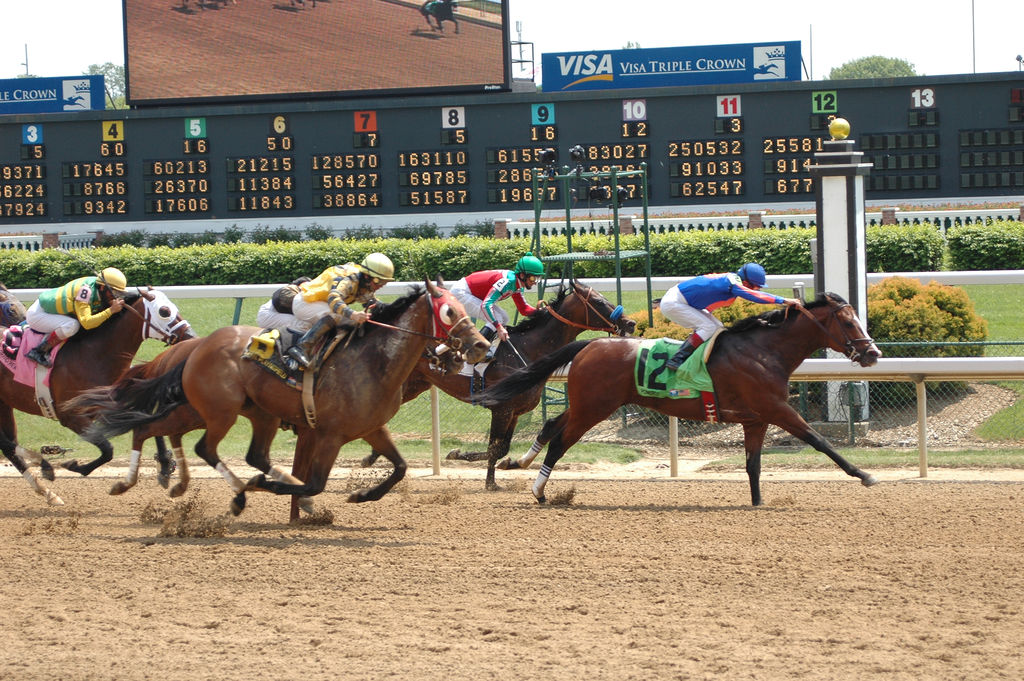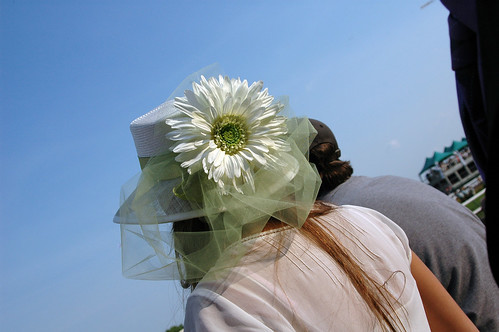This weekend marks the 140th running of the Kentucky Derby. While last year we celebrated with hat words, this year we’re rounding up now-common phrases that you might not know come from horse racing. And we’re off!
across the board
Across the board, meaning “pertaining to all categories or things,” originated around 1903 as a betting term in horse racing. According to the Oxford English Dictionary, wagering across the board means betting that your horse will finish “in either first, second, or third place.”
charley horse
You know the feeling: that sudden tightening of your calf or thigh that just won’t stop. So what does a muscle cramp have to do with a horse named Charley?
The term charley horse began as baseball slang around the late 1800s, says the OED. The origin is unknown, but there are a few different theories.
Phrase Finder and Wiktionary both say the phrase might be named for pitcher Charlie “Old Hoss” Radbourn, who suffered from such an ailment. The Online Etymology Dictionary says it may be from “from somebody’s long-forgotten lame racehorse,” perhaps specifically, as Word Origins proposes, a workhorse with a hobbled, stiffened gait as a result of pulling heavy loads, as witnessed by baseball player Joe Quest.
According to Quest, “the ball players troubled with the ailment hobbled exactly as did the old horse,” and so “Quest dubbed it ‘Charley horse.’”
dark horse
Dark, in addition to meaning “lacking light” or having a complexion that “isn’t fair,” also means concealed, secret, or mysterious. By that token, a dark horse is “a horse about whose racing powers little is known,” says the OED. The term was first used by Benjamin Disraeli in his 1831 novel, The Young Duke:
The first favourite was never heard of, the second favourite was never seen after the distance post, all the ten-to-oners were in the rear, and a dark horse, which had never been thought of, and which the careless St. James had never even observed in the list, rushed past the grand stand in sweeping triumph.
Dark horse now often refers to any unexpected success, while in politics, a dark horse candidate is one who unexpectedly comes up from behind.
front runner
A front runner is the leading candidate in a contest, competition, or election and comes from the horse racing term referring to “a horse that runs best while in the lead.”
give-and-take
Give-and-take, the art of compromise or “a lively exchange of ideas or conversation,” originally referred to, in horse racing, the give and take plate, says the OED, “a prize for a race in which the horses which exceed a standard height carry more, and those which fall short of it less, than the standard weight.”
By 1769, give-and-take also referred to races in general “in which bigger horses were given more weight to carry, lighter ones less.” It was around 1778 that the phrase gained the meaning, “the practice of mutual yielding,” of which the earliest recorded citation is from one of our favorite writers, Fanny Burney, in her novel Evelina: “Give and take is fair in all nations.”
hands down
To win something hands down means to win it easily. It comes from the practice of horse racing jockeys loosening the reins when it seemed certain that they would win.
home stretch
When you’re in the home stretch, also known as the home straight, you’re almost done with whatever you’re trying to accomplish. That meaning came about around 1860, according to the OED, while the horse racing term is from about 1841 and refers to the final length, or stretch, of the racetrack.
The word stretch refers to “a continuous or unbroken length, area, or expanse,” as in “an empty stretch of highway,” and by extension, “a straight section of a racecourse or track, especially the section leading to the finish line.”
in (or out) of the running
In horse racing, those horses in the running are the lead competitors. This term came about in the mid-1800s, according to the OED, while the figurative meaning referring to viable, and not so viable, political candidates originated a couple of years later.
a run for one’s money
To give someone a run for their money means to give them a challenge. The term originated in horse racing around 1839, says the OED, with the meaning “to have (or get, want, etc.) a successful race from a horse one has backed, (in early use) esp. when that horse appeared likely to be scratched.” (Scratched here, by the way, means “withdrawn.”)
Around 1874, the term gained the extended sense of getting “value or satisfaction in return for one’s expenditure or exertions.” The challenge sense came about shortly after that, around 1886.
running mate
Running mate is yet another political term that we get from horse racing. It refers to a “candidate or nominee for the lesser of two closely associated political offices.” In other words, a vice-presidential candidate is the running mate of a potential POTUS.
In horse racing, a running mate is “a horse used to set the pace in a race for another horse,” and also, according to the OED, “a horse that runs alongside a trotting or pacing horse in double harness, relieving that horse of some of the effort of pulling a load.”
[Photo via Flickr, CC BY 2.0 by John Athayde]


